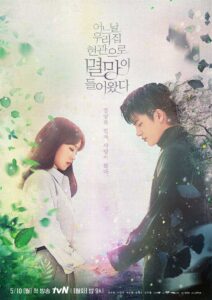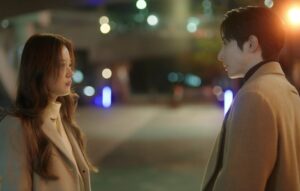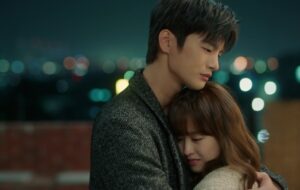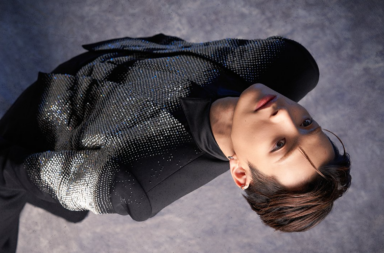
Doom at Your Service had a very promising start. The opening episodes of the show featured a large ensemble of intriguing characters and a well-realized magical realist world. However, as Doom at Your Service continued its run, cracks started to emerge. The drama began to lean heavily into tropes, and its character writing became messy and unconvincing.
Even as its better angels lost ground though, the show held onto some of its original spark. Kept afloat by a collection of strong performances, Doom at Your Service’s characters stayed easy to root for. Even more importantly, the show continued to deliver truly memorable scenes, albeit sporadically. Sometimes these moments came thanks to the visual flair of director Kwon Young-il, sometimes thanks to the surprisingly original philosophical ideas of writer Im Me-ari, and the best sequences of all combined both.
Unfortunately, in its final stretch, Doom at Your Service’s magic goes away entirely. There are still a handful of enjoyable scenes. But even the things that worked during most of the drama eventually lose their charm. Emotional climaxes are rehashed one time too many, and the visually beautiful fantasy sequences’s luster fades as it becomes clear that they carry little meaning. The dark shadow that Doom at Your Service’s poor plotting and lazy follow through cast ultimately snuff out all of the show’s light.

One of Doom at Your Service’s initial strengths was its eclectic mix of elements. In terms of genre, the show contains aspects of a romantic comedy, a workplace sitcom, a melodramatic fantasy, a psychological thriller, and a healing drama. Doom at Your Service also introduced many different story threads in its first few episodes that showed promise.
Because of this setup, Doom at Your Service seemed to be an embarrassment of riches. As the show progressed though, it became clear that the drama didn’t actually have a plan for what it was going to do with all these seeds. A show that has so many things up in the air, and no plan for how to bring everything down to earth in a satisfying way, is (with apologies for the pun) doomed.
One of the most frustrating aspects of Doom at Your Service’s conclusion is how so many things ultimately fail to connect to each other, leaving each plot in the show stranded on its own narrative island forever. For example, Cha Joo-ik (Lee Soo-hyuk), Na Ji-na (Shin Do-hyun), and Lee Hyun-kyu’s (Kang Tae-oh) love triangle never links into Doom at Your Service’s fantasy side, and the attempts to bring all the characters together in a common universe through last minute meet cutes are sloppy. When a show introduces many threads, audiences expect that those threads will eventually intertwine to form a tapestry. If that doesn’t happen, it is deeply disappointing.

It it tempting to cut Doom at Your Service some slack by noting how hard it would be to pull all of the drama’s elements into a single cohesive whole. However, other shows have done it before. A comparison can be made between Doom at Your Service and iconic drama Goblin. Both shows juggle a lot of balls at once, and at their best, they also share a distinctive mood of bittersweet sentimentality. Goblin is far from a perfect drama, but unlike Doom at Your Service, it painstakingly and successfully weaves its many storylines into one cohesive narrative with shared themes of fated love, second chances, and the power of individual choice.
In an alternate universe, Doom at Your Service could have salvaged itself in its final episodes and also earned the label of an imperfect yet satisfying drama. A window into that different path is Episode 14, which is the strongest of Doom at Your Service’s final four entries. The episode mostly focuses on the gradual goodbye between central couple Myul Mang (Seo In-guk) and Tak Dong-kyung (Park Bo-young). In a particularly memorable sequence, Myul Mang and Dong-kyung walk in a post-apocalyptic world, witnessing the disaster that they will avert thanks to their imminent sacrifice. The scene is hauntingly tranquil, and effectively communicates the stakes of Myul Mang and Dong-kyung’s relationship in a way that the drama otherwise fails to do.
When Myul Mang eventually fades away before Dong-kyung’s heartbroken eyes, it is a moment of tragedy, but also the ending that suits Doom at Your Service best. If the show had called it quits there, it would have stayed true to its bittersweet roots, and there could have been a lot of satisfaction for viewers in that. Unfortunately, Doom at Your Service drags on for two more episodes that amount to romantic comedy-style filler. The show also forces a happy ending that is totally unearned. Seeing Seo In-guk and Park Bo-young smile contentedly at each other is very nice, but should an entire drama and its continuity be sacrificed for this?

Episodes 15 and 16 truly drive the nail into Doom at Your Service’s narrative coffin. They represent a tremendous failure of nerve on the show’s part. Doom at Your Service abandons the emotional tone, characterizations, and genre blending that once made it so captivating. Instead, the show indulges in cheap resolutions and fills its minutes with copy-paste scenarios that could and do exist in a thousand other dramas. As a sad reminder of what could have been, Doom at Your Service’s actors still do their level best to turn in good performances to the very end, and Director Kwon Young-il also comes through with a few final visually stunning touches.
Many dramas would love to have the ingredients that Doom at Your Service had at its disposal. To see the show waste these gems is frustrating. Doom at Your Service came into the world full of promise, and delivered some genuinely stellar sequences during its run. Taken as a whole though, Doom at Your Service is mostly a reminder that it doesn’t matter how many great elements a show has if it doesn’t know how to use them.
(Images via tvN, Viki)


